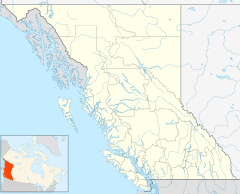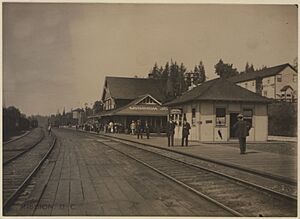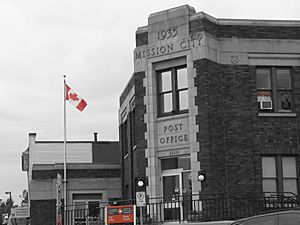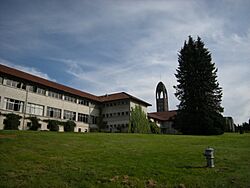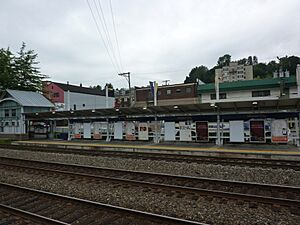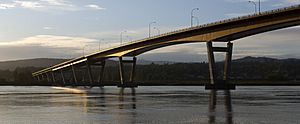Mission, British Columbia facts for kids
Quick facts for kids
Mission
|
||
|---|---|---|
| City of Mission | ||
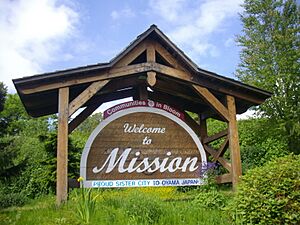 |
||
|
||
| Motto(s):
"The Future Our Mission"
|
||
| Country | Canada | |
| Province | British Columbia | |
| Regional district | Fraser Valley | |
| Founded | 1868 | |
| Incorporated | 1892 | |
| Incorporated (city) | March 29, 2021 | |
| Area | ||
| • Total | 227.65 km2 (87.90 sq mi) | |
| Population
(2021)
|
||
| • Total | 41,519 | |
| • Density | 170.6/km2 (442/sq mi) | |
| Time zone | UTC-8 (PST) | |
| Forward sortation area |
V2V, V4S
|
|
| Area code(s) | 604, 778, 236, 672 | |
Mission is a city in the Lower Mainland area of British Columbia, Canada. It was first set up as a district in 1892. Over the years, it grew to include more villages and rural areas. In 1969, it added the original Town of Mission City, which had been a separate part of the region for a long time.
Mission is located on the north side of the Fraser River. It is backed by mountains and lakes that look out over the Fraser Valley. It's about 65 kilometers (40 miles) southeast of Vancouver. The city borders Abbotsford to the south and Maple Ridge to the west. To the east are areas like Hatzic and Dewdney that are not part of any city. On March 29, 2021, Mission officially became a city.
Contents
- Exploring Mission's Landscape
- Mission's Past: A Look Back
- Mission's Economy
- Getting Around Mission
- Mission's Weather
- Who Lives in Mission?
- Learning in Mission: Schools
- Sports and Fun in Mission
- Famous People from Mission
- Areas and Communities in Mission
- Sister City
- Freedom of the City Awards
- Images for kids
- See also
Exploring Mission's Landscape
Unlike other towns in the Fraser Valley, Mission is mostly covered in forests. It has only small flat areas along the Fraser River. Some layers of farmland rise north of the main city area. Mission was once famous for its berry farms. In the 1930s and 1940s, its slogan was "Home of the Big Red Strawberry."
The western part of Mission is bordered by the lower Stave River. This river mainly consists of two large lakes, Stave Lake and Hayward Lake, which are used for making electricity. Even though most people in Mission live east of the Stave River, more than half of the northern land area is west and north of it. A small part of the lower Stave River still flows freely before joining the Fraser River at Ruskin. The last part of this river forms the border with Maple Ridge to the west.
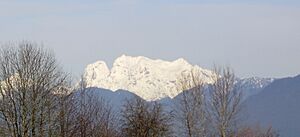
Over 40% of Mission is a tree farm. This makes it one of only two communities in British Columbia with its own city-run tree farm. Mission's tree farm celebrated its 50th birthday in 2008. It covers much of the northern part of the district, including the area west of the Stave River.
The eastern border of Mission is roughly where the Mission uplands meet the flat, fertile land of Hatzic Prairie. This area looks like much of the rest of the Fraser Valley. Communities from Hatzic east through Dewdney and Nicomen Island to Deroche are closely connected to Mission. However, they have never officially joined the city. The local economy in these areas relies on dairy, berry, and corn farming. There is also a large First Nations community at the Leq' a: mel First Nation reserves on Nicomen Island and Deroche.
Mission's Past: A Look Back
The Town of Mission City got its name from the nearby St. Mary's Mission and Residential School, which was started in 1861. The town began as a land sale event. On May 19, 1891, the main business and housing areas were sold off in a "Great Land Sale." Buyers came from Vancouver and Eastern Canada by train. Soon after, in 1893, Harry Brown French started the Mission Regional Chamber of Commerce. This was the first Board of Trade in British Columbia. Some of the first houses and shops were designed to look like small towns in southern Ontario to attract buyers.
At the time of its founding, the Mission Railway Bridge, which opened in 1891, was the only way to cross the Fraser River in the Fraser Valley. All train traffic between Vancouver and the United States had to go through Mission until a new bridge was built in New Westminster in 1904. The Mission railway bridge also worked as a one-way car bridge until 1973, when the new Mission Bridge was finished. This bridge is important because it's at the start of the tidal wave on the Fraser River. Its water level gauge helps measure the river's annual spring flood.

Mission City's first main shopping area was in a small flat space between the train tracks and the river. After a big flood in 1894, the main area moved north of the train line, at the bottom of the hill. This small shopping street, now called First Avenue, was a major business center in the Fraser Valley for many years. After the 1894 flood, Chinese merchants and workers took over the empty buildings and lots in the old downtown, creating a Chinatown that lasted until the 1920s.
The western part of the district, the Stave Valley, is mostly rural and forested. However, its river was home to British Columbia's largest hydroelectric project until 1961. This project, built by the British Columbia Electric Railway (BCER), provided power for Vancouver's electric streetcar system. The Stave Falls Power Co. used a small railway to carry people and goods up the river canyon to the dam at Stave Falls. When the Ruskin Dam was built (finished in 1931), the railway was moved higher up to go around the new Hayward Lake. The railway is no longer used, but its old path is now part of a walking trail around the lake.
Near the powerhouses at Stave Falls, there was once a large community of about 300 houses. This community was served by the railway, which connected to the CPR line at Ruskin. Today, people in the Stave Falls area live further away from the dams, in a rural farming and wilderness area south of Rolley Lake Provincial Park.
The building of Highway 1 on the south side of the Fraser River in the early 1960s led to a huge increase in population and large shopping malls in nearby Abbotsford. As a result, Mission lost its main department store, and its Main Street businesses lost a lot of customers to the new malls across the river. This trend sped up when the new Mission Bridge opened in the mid-1970s.
Despite having a strong business community and new shopping centers on the edges of the old downtown, Mission's retail area has not fully regained its past importance in the Fraser Valley. However, a growing population of people moving from larger cities, along with a new commuter rail line (the West Coast Express) directly to downtown Vancouver, has started to reverse this trend.
Outside the main "urban" area, which used to be the Town of Mission City, the former District of Mission was made up of several distinct rural communities. Each had its own history and sometimes a unique cultural feel. For example, Silverdale, 7 kilometers (4.3 miles) west of Mission, was settled in the 1880s by Italian immigrants. Neighboring Silverhill was founded by a Finnish group. Other places like Ferndale, Cedar Valley, and Hatzic were farming communities with people from various backgrounds. Before World War II, there was a large Japanese-Canadian population in the Mission area. They worked in berry farming, logging, and fishing.
In 1954, Benedictine monks bought land near Mission. There, they built their Westminster Abbey and Seminary of Christ the King. They have lived there ever since, running their own farm and teaching high school and college students.
The berry industry, once the most important in the district, was the focus of the town's yearly summer event, the Strawberry Festival. The festival started in 1946. However, due to the impact of the relocation of Japanese Canadians during the war and a big flood in 1948, the strawberry theme was stopped. The town then hosted the Western Canada championships of the Soap Box Derby until 1973. The Derby has been brought back in recent years.
Another major industry in Mission was logging. The town's mills were known for being the world's largest suppliers of red cedar shakes and shingles. The District of Mission has run its own tree farm for many years, covering most of its northern and northwestern mountain forests. This tree farm has been a model for forest management throughout British Columbia and provides a unique income for the city.
In the 1960s and 1970s, there were many productive mills along Mission's waterfront. For many years, Mission was the world capital of red cedar shake production. Nearby, the Eddy Match Co. was the largest matchstick-making plant in the world until it closed in the 1960s.
Mission is also known for its long-standing professional dragstrip, Mission Raceway Park. It was moved outside the lower part of town to reduce noise in nearby homes and businesses.
In 1972, a large piece of land in Mission's Ferndale area was bought by the government. Two large correctional facilities were built there: a minimum security facility and a medium security prison. The northern part of the district also has some wilderness work camps for young offenders and low-risk convicts. These camps have helped clear large forests of flooded trees from Stave Lake, making the lake open for water activities.
Mission's Economy
Historically, forestry, hydroelectricity (power from water), and agriculture were Mission's main industries. These provided the base for many related shops and services. More recently, better transportation has helped the manufacturing sector grow beyond just sawmills and food processing.
Industries related to forests and wood are the most important in manufacturing. They focus on making redcedar shakes and shingles. Mission also has the only city-owned tree farm license in British Columbia.
Agriculture is mostly found in a narrow strip along the Fraser River. The Dewdney-Deroche district, east of Mission, has most of the farms in the area. There are about 96 commercial and hobby farms. Dairy farming is the main agricultural business. Other sources of income include poultry, hogs, beef, and vegetables.
Mission's largest employer is the local school district, School District #75. The second largest employer is the city government itself.
Getting Around Mission
Transportation in Mission includes Abbotsford-Mission Highway 11 and the Lougheed Highway 7. You can also get to Mission by commuter train, the West Coast Express. This train runs five times a day, five days a week, between Vancouver and Mission City Station. Bus service in Mission is provided by the Central Fraser Valley Transit System, connecting to Abbotsford. There's also TransLink service to Coquitlam Central Station via route 701.
Three days a week, Via Rail's The Canadian train offers eastbound service from Mission Harbour railway station.
Mission is different from some other Fraser Valley communities because it has access to the Fraser River. The Fraser River near Mission is mostly untouched, making Mission a great starting point for many water activities all year round. Boat tours leave from Mission's docks on Harbour Avenue, which are also home to fishing boats. The Fraser River is famous for its salmon runs and a population of green sturgeon.
Mission's Weather
Mission has an oceanic climate (Cfb on the Köppen climate classification scale) because it's close to the Pacific Ocean. This means it gets plenty of rain all year, but with less rain in the summer.
| Climate data for Mission | |||||||||||||
|---|---|---|---|---|---|---|---|---|---|---|---|---|---|
| Month | Jan | Feb | Mar | Apr | May | Jun | Jul | Aug | Sep | Oct | Nov | Dec | Year |
| Record high °C (°F) | 15.6 (60.1) |
20.6 (69.1) |
22.5 (72.5) |
28.0 (82.4) |
36.5 (97.7) |
42.9 (109.2) |
37.8 (100.0) |
36.5 (97.7) |
36.0 (96.8) |
27.0 (80.6) |
18.9 (66.0) |
17.5 (63.5) |
42.9 (109.2) |
| Mean daily maximum °C (°F) | 5.1 (41.2) |
8.0 (46.4) |
10.9 (51.6) |
14.6 (58.3) |
17.4 (63.3) |
19.9 (67.8) |
23.5 (74.3) |
23.4 (74.1) |
20.9 (69.6) |
14.9 (58.8) |
8.9 (48.0) |
6.0 (42.8) |
14.5 (58.1) |
| Daily mean °C (°F) | 2.5 (36.5) |
4.7 (40.5) |
6.8 (44.2) |
9.7 (49.5) |
12.6 (54.7) |
15.1 (59.2) |
17.9 (64.2) |
18.0 (64.4) |
15.6 (60.1) |
10.9 (51.6) |
6.1 (43.0) |
3.5 (38.3) |
10.3 (50.5) |
| Mean daily minimum °C (°F) | −0.2 (31.6) |
1.3 (34.3) |
2.7 (36.9) |
4.8 (40.6) |
7.7 (45.9) |
10.3 (50.5) |
12.3 (54.1) |
12.5 (54.5) |
10.4 (50.7) |
6.7 (44.1) |
3.2 (37.8) |
0.9 (33.6) |
6.1 (43.0) |
| Record low °C (°F) | −14.4 (6.1) |
−15.5 (4.1) |
−12.2 (10.0) |
−2.8 (27.0) |
−2.2 (28.0) |
2.2 (36.0) |
4.4 (39.9) |
5.0 (41.0) |
0.6 (33.1) |
−3.5 (25.7) |
−13.3 (8.1) |
−19.4 (−2.9) |
−19.4 (−2.9) |
| Average precipitation mm (inches) | 217.0 (8.54) |
190.7 (7.51) |
154.6 (6.09) |
129.7 (5.11) |
102.5 (4.04) |
100.6 (3.96) |
63.6 (2.50) |
74.1 (2.92) |
77.9 (3.07) |
141.2 (5.56) |
252.7 (9.95) |
260.1 (10.24) |
1,764.5 (69.47) |
| Average rainfall mm (inches) | 197.3 (7.77) |
178.8 (7.04) |
151.2 (5.95) |
129.5 (5.10) |
102.5 (4.04) |
100.6 (3.96) |
63.6 (2.50) |
74.0 (2.91) |
77.9 (3.07) |
141.1 (5.56) |
249.1 (9.81) |
242.9 (9.56) |
1,708.5 (67.26) |
| Average snowfall cm (inches) | 19.7 (7.8) |
11.9 (4.7) |
3.4 (1.3) |
0.2 (0.1) |
0 (0) |
0 (0) |
0 (0) |
0 (0) |
0 (0) |
0.1 (0.0) |
3.6 (1.4) |
17.2 (6.8) |
56.0 (22.0) |
| Average precipitation days (≥ 0.2 mm) | 19.3 | 16.9 | 18.0 | 15.0 | 15.6 | 14.4 | 9.7 | 9.6 | 9.8 | 15.4 | 20.7 | 21.6 | 186.0 |
| Average rainy days (≥ 0.2 mm) | 17.3 | 15.8 | 17.6 | 15.0 | 15.6 | 14.4 | 9.7 | 9.6 | 9.8 | 15.4 | 20.4 | 19.5 | 180.1 |
| Average snowy days (≥ 0.2 cm) | 4.2 | 2.3 | 1.1 | 0.17 | 0.03 | 0 | 0 | 0 | 0 | 0.06 | 0.82 | 3.7 | 12.4 |
| Source: Environment Canada | |||||||||||||
Who Lives in Mission?
In the 2021 Canadian census, Mission had a population of 41,519 people. This was a 7.7% increase from its 2016 population of 38,554. The city covers 226.98 square kilometers (87.64 square miles).
Mission has a young population, with a median age of 36.4 years old, according to the 2001 Canadian census.
Different Backgrounds in Mission
The largest group of people in Mission are those of European background, making up about 74% of the population. This group includes people from British, German, Dutch, Finnish, Norwegian, Scandinavian, Italian, Hungarian, Polish, and French-Canadian backgrounds.
There is a significant First Nations community, making up 8.6% of the population. The Peckquaylis Indian Reserve, which used to be the St. Mary's Residential School, is a center for services and governments of the Sto:lo communities in the eastern area.
The largest visible minority group in Mission are South Asians, mainly Indo-Canadians, who make up 10.7% of the population. Mission's Indo-Canadian community has been active since the early 1900s. For example, Naranjan Grewall became the first Indo-Canadian elected to public office in Mission City's government. In 2021, there were 4,330 South Asian people in Mission.
Mission's Japanese-Canadian community started in 1904. Many early immigrants were farmers and "picture brides" (women who arranged marriages by mail). Organizations like the Japanese Farmer's Association and the Mission Judo Club were formed. By 1930, Japanese people in Mission owned a lot of land. Before World War II, 30% of Mission's public school students were of Japanese background. However, the Japanese Canadian internment during World War II greatly affected this community. Their properties were taken, and many Japanese people chose not to return to Mission after the war, even when they were allowed to in 1949.
| Panethnic group |
2021 | 2016 | 2011 | 2006 | 2001 | |||||
|---|---|---|---|---|---|---|---|---|---|---|
| Pop. | % | Pop. | % | Pop. | % | Pop. | % | Pop. | % | |
| European | 29,970 | 73.77% | 29,990 | 79.99% | 29,395 | 82.88% | 28,330 | 83.72% | 26,540 | 86.76% |
| South Asian | 4,330 | 10.66% | 2,940 | 7.84% | 2,520 | 7.11% | 2,220 | 6.56% | 1,655 | 5.41% |
| Indigenous | 3,380 | 8.32% | 2,910 | 7.76% | 2,265 | 6.39% | 1,995 | 5.9% | 1,490 | 4.87% |
| Southeast Asian | 1,015 | 2.5% | 410 | 1.09% | 100 | 0.28% | 260 | 0.77% | 175 | 0.57% |
| East Asian | 800 | 1.97% | 520 | 1.39% | 435 | 1.23% | 535 | 1.58% | 305 | 1% |
| Latin American | 330 | 0.81% | 305 | 0.81% | 175 | 0.49% | 185 | 0.55% | 240 | 0.78% |
| African | 280 | 0.69% | 260 | 0.69% | 315 | 0.89% | 195 | 0.58% | 85 | 0.28% |
| Middle Eastern | 240 | 0.59% | 55 | 0.15% | 115 | 0.32% | 65 | 0.19% | 30 | 0.1% |
| Other | 280 | 0.69% | 90 | 0.24% | 125 | 0.35% | 60 | 0.18% | 60 | 0.2% |
| Total responses | 40,625 | 97.85% | 37,490 | 96.54% | 35,465 | 97.36% | 33,840 | 98.07% | 30,590 | 97.82% |
| Total population | 41,519 | 100% | 38,833 | 100% | 36,426 | 100% | 34,505 | 100% | 31,272 | 100% |
- Note: Totals greater than 100% due to multiple origin responses.
Religious Groups in Mission
According to the 2021 Canadian census, the main religious groups in Mission include:
- People with no religious affiliation: 23,160 (57.0%)
- Christians: 12,905 (31.8%)
- Sikhs: 3,275 (8.1%)
- Hindus: 380 (0.9%)
- Muslims: 285 (0.7%)
- Buddhists: 275 (0.7%)
- Jews: 55 (0.1%)
- Indigenous Spirituality: 35 (0.1%)
Learning in Mission: Schools
School District 75 Mission runs the public schools in Mission and the areas to the east. Students from elementary schools in Deroche/Lake Errock, Dewdney, Nicomen Island, Hatzic Island, Hatzic Prairie/Durieu, and McConnell Creek all go to Mission Secondary School for high school.
The Conseil scolaire francophone de la Colombie-Britannique operates one French-language primary school in Mission called école des Deux-rives.
Sports and Fun in Mission
Mission offers many sports activities, similar to other cities in the region. One special feature is the large network of outdoor trails within the Tree Farm and Interpretive Forest. Mission has world-class mountain bike trails and many backcountry hiking opportunities within the city limits.
Mission is also home to a Pacific Junior Hockey League team, the Mission City Outlaws.
| Club | League | Sport | Venue | Established | Championships |
|---|---|---|---|---|---|
| Mission City Outlaws | PJHL | Ice hockey | Mission Leisure Centre | 2003 |
1 |
Famous People from Mission
Many talented people have come from Mission, including:
- Pop singer and Canadian Idol finalist Carly Rae Jepsen
- Electro-pop singer Lights Poxleitner
- 1976 Olympic silver medalist swimmer Gary MacDonald
- Poker Pro Player Brad Booth
- NHL athlete Gage Goncalves
- Big band era musician Mart Kenney and his wife, Norma Locke
- Singer-songwriter and Juno nominee Paul Janz
- Dave Faber and Ray Bull of Faber Drive
- 1988 Olympic short-track speedskater Eden Donatelli
- Swimmer Brent Hayden (Canadian Record holder in the 50m, 100m, & 200m freestyle, 2007 100m freestyle World Champion, 3x Olympian (2004, 2008, 2012), and 2012 Olympic Bronze Medalist)
- Actor Graham Wardle from Heartland
- WNBA (Sacramento Monarchs) basketball player Kim Smith
- 1996 and 2000 Olympic swimmer Shannon Shakespeare
- High jump athlete Debbie Brill
- Justice of the Superior Court of Justice, Ontario Todd Ducharme
- Former logging company owner and British Columbia political figure Norman Jacobsen
- Margaret Lyons, first female vice-president of the Canadian Broadcasting Corporation.
- Hip-hop artist Powfu.
- Hip-hop artist Lil Windex
Areas and Communities in Mission
Mission has several neighborhoods, including some rural areas that were part of the district before it became a city. These areas still have a strong local identity. Here are some of the historical neighborhoods:
- Cade-Barr
- Cedar Valley
- Cherry Hill
- Clay Road
- Deroche
- Dewdney
- Historic Downtown (1st Avenue business strip)
- Historic Central Mission (2nd Avenue to 7th Avenue)
- Hatzic
- Hillside
- Ferndale
- Keystone Road
- Silverdale
- Silverhill
- Stave Falls
- Stave Gardens
- Ruskin (also partly in Maple Ridge)
- Steelhead
- Richards Road
- West Heights
Nearby Communities (Not Part of Mission)
Some communities and rural areas east of Mission are closely connected to the city. This is partly because of School District No. 75. Also, Mission is the main service center for the north side of the Fraser River between Maple Ridge and Agassiz-Kent. These communities include:
- Hatzic Valley
- Dewdney
- Nicomen Island
- Deroche
- Lake Errock
Mission's Neighbors
 |
Garibaldi Ranges/Douglas Ranges |  |
||
| Maple Ridge | Dewdney/Deroche | |||
| Langley | Abbotsford | Chilliwack |
Sister City
Mission has a sister city relationship with:
 Oyama, Shizuoka, Japan, since October 1996
Oyama, Shizuoka, Japan, since October 1996
Freedom of the City Awards
The "Freedom of the City" is a special honor given to people and military units. Here are some who have received it in Mission:
Individuals
- Abraham "Abe" Neufeld: 2007.
- Valerie Billesberger: April 26, 2022.
- James "Jim" Hinds: April 26, 2022.
- Glen Kask: April 26, 2022.
- Doug Pearson: April 26, 2022.
Images for kids
See also
 In Spanish: Mission (Columbia Británica) para niños
In Spanish: Mission (Columbia Británica) para niños



